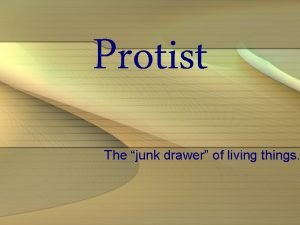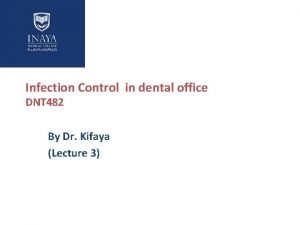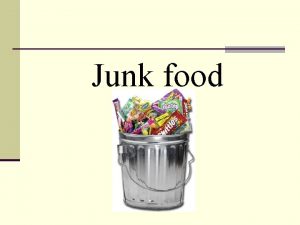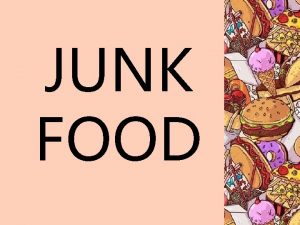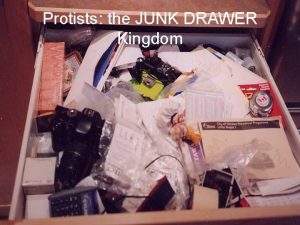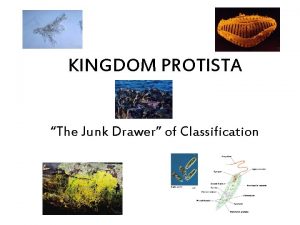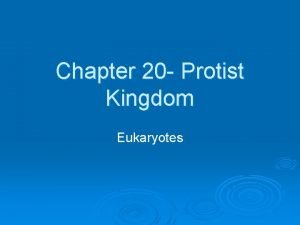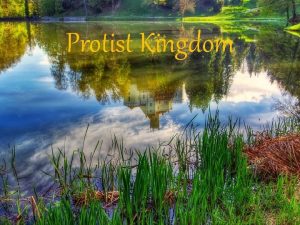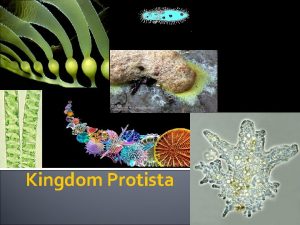Protist The junk drawer of living things Kingdom
















- Slides: 16

Protist The “junk drawer” of living things.

Kingdom Protista protist- single-celled or simple multicelled microscopic organisms that contain a nucleus *Some protists (seaweeds) can be seen without a microscope

General Characteristics • Junk-drawer kingdom because all organism with cells having a nucleus that do not belong in the fungi, plant, or animal kingdoms are placed in the Kingdom Protista (collection of leftover organisms) • Most protists live in water (fresh water or salt water) • All protists are eukaryotes - organisms that have a nucleus • Protists are classified by the way they obtain energy 1. Fungus-Like (Decomposers) 2. Animal-Like (Consumers - heterotrophs) 3. Plant-Like (Producers – autotrophs)

General Characteristics Continued • Scientists think that fungi, plants, and animals all probably evolved from ancient protists.

1. Funguslike Protists - Decomposers • Funguslike protists absorb food from their environment. They take in material from the soil or from other organism and break material down in order to obtain energy. • The funguslike protists are decomposers (type of consumer) – organisms that feed on and break down dead plant and animal matter • Types of funguslike protists - slime molds - water molds

1. Funguslike Protists – Slime Mold • Slime molds are thin masses of living matter • Slime molds eat bacteria, yeast, and small bits of decaying plant and animal matter • They surround food particles and digest them Plasmodium slime molds are gathered and eaten in Mexico! Usually the plasmodium comes out at night and is collected by moonlight in jars. The plasmodia are brought home, where they are mixed and eaten like scrambled eggs!!

1. Funguslike Protists – Slime Mold More Slime Molds Slime molds are often found on old well-rotted logs, because there they can find the moisture and bacteria required for survival.

1. Funguslike Protists – Water Mold • Forms fuzzy growth on food • Water molds live in water, moist soil, or other organisms

2. Plantlike Protists - Producers/Autotrophs • Most are aquatic (live in water) • Red algae, brown algae, green algae, diatoms, dinoflagellates, and euglenoids are types of plantlike protists • Plankton – are protists that drift in water (plankton that perform photosynthesis are called phytoplankton) • Phytoplankton, a single-celled algae, make most of the world’s oxygen • Plantlike protists are producers/autotrophs producer (autotrophic) - use the sun’s energy to make food through photosynthesis

2. Plantlike Protists - Red Algae These multi-cellular protists live mainly in tropical marine waters, attached to rocks or other algae

2. Plantlike Protists - Brown Algae They attach to rocks or form large floating beds in ocean waters. Some grow 60 m in just one season

2. Plantlike Protists - Green Algae Most diverse group of plantlike protists

Animal-Like Protists (Protozoa) – Consumers/Heterotrophs • Single-celled consumers or parasites -consumer/heterotrophic – a living that gets its energy by eating other living things in a food chain • Protists that eat other organism, or decaying parts of other organisms, are animal-like protists, or protozoa • Most can move -paramecium move about using short wavy strands called cilia -some swim with one or more long whiplike structures called flagella -flexible cells -amoeba ooze along surfaces using pseudopods (false feet) • Some protists live as parasite – an organism that absorbs nutrients from the body of another organism, often harming it in the process (malaria)

Animal-Like Protists (Protozoa) – Consumers/Heterotrophs Amoeba Paramecium Example of Organisms with Flagella

Reproduction of Protists • Asexual reproduction -Some protists reproduce asexually by fission • Sexual reproduction -Some animal-like protists reproduce sexually by a process called conjugation - two protist join together and exchange genetic material using their micronuclei

Example of Binary Fission Example of Conjugation
 Protists junk drawer
Protists junk drawer Junk drawer robotics
Junk drawer robotics Nnn ruled
Nnn ruled Roman empire
Roman empire Old kingdom middle kingdom new kingdom
Old kingdom middle kingdom new kingdom Old kingdom middle kingdom new kingdom
Old kingdom middle kingdom new kingdom Pyramid hesd
Pyramid hesd Smallest living unit of life
Smallest living unit of life Domain eukarya, kingdom plantae
Domain eukarya, kingdom plantae Characteristics of kingdom protista
Characteristics of kingdom protista 7 life processes
7 life processes What is the odds and ends kingdom
What is the odds and ends kingdom Protista mobility
Protista mobility Kingdom plantae characteristics
Kingdom plantae characteristics Living non living dead
Living non living dead Is mold living or nonliving
Is mold living or nonliving Root locus drawer
Root locus drawer
